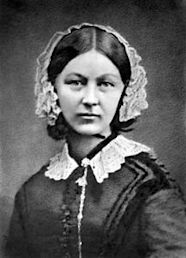Biografía
She was born in Florence in 1820, but was raised in Derbyshire, England, in a wealthy landowner family. Her father, William Nightingale, was involved in the anti-slavery movement, and was a fierce believer in the fact that women, and her daughters, in particular, deserved an education. Her sister and she learned Italian, Latin, Greek, history and mathematics, but also sewing and embroidery so that they could become the perfect wives, which was the only fate for Victorian girls who came from a good family. Among her tutors, she had the renowned mathematician James Joseph Sylvester. She received lessons in arithmetic, geometry and algebra. Belgian scientist Adolphe Quetelet, who had applied statistics into data of several fields, also had an influence on her.
At the age of 23, she opposed her parents by telling them she wanted to become a nurse, because it was a profession associated to working-class women. Her mother was concerned about finding her daughter a good husband, a failed task considered that Florence never married.
She turned down all her suitors and demonstrated her determination to achieve her goals: "tending to the sick full-time, with nothing that could set her back".
Before she became a full-time nurse, she was a mathematics tutor for children, with a well-planned, definite program. In her "Lesson plans for teaching arithmetic and geometry" she included problems based on the lives of her students. She was particularly concerned with the education of girls.
In 1850, she started her nursing studies at the Saint Vincent de Paul Institute in Alexandria, Egypt. That same year, she worked at Kaiserwerth's hospital, near Düsseldorf. This fact marked a milestone in her life, and she wrote her experiences, which became her first published work. When she came back to London in 1853, took the post of superintendent at the Institute for the Care of Sick Gentlewomen free of pay.
In 1854, the British secretary of war asked Florence to become a nurse-administrator to supervise the introduction of nurses in military hospitals during the Crimean War. Her official title was Superintendent of the Female Nursing Establishment of the English General Hospitals in Turkey. Florence moved to Scutari, where the main British hospital was. The situation at the hospital was alarming. The main causes of death were diseases such as typhus, cholera and dysentery, which meant that soldiers were seven times more likely to die after contracting one of these diseases at the hospital than in the battlefield.
Although being a woman implied constantly fighting the military authorities, she reformed the hospital system little by little. She compiled data and systematised the practice of keeping records; this information was later used as a tool to improve military and city hospitals. Her knowledge of mathematics played a great role when she used the data that she had collected to calculate the mortality rate at the hospital. These calculations demonstrated that improving the sanitary methods used would reduce the number of deaths. She used these statistics to create her polar area diagram or 'coxcomb', as she called it. These were used to give a graphic representation of the mortality rate during the Crimean War (1854-1856).
She took care of the sick all day and night long. At night, she could be seen tending the sick with a small lamp, which earned her the nickname of "the Lady with the lamp". Later on, American poet Henry Wadsworth Longfellow (1807 –1882) immortalised the term in his poem "Santa Filomena".
In 1856, Florence Nightingale came back to England as a national hero. She used her statistics to show the need for a sanitary reform in all military hospitals. In 1857 she conducted a formal study that ended with the creation of the Royal Commission on the Health of the Army.
Florence Nightingale's contribution to the field of statistics was rewarded with her appointment in 1858 as a member of the Royal Statistical Society. She was the first woman to hold this position. Besides, in 1874, she became an honorific member of the American Statistical Association.
In 1860, she inaugurated the Florence Nightingale Faculty of Nursing and Midwifery at St. Thomas' Hospital in London. It was financed through the Nightingale Fund, a public fund established during Florence's time in Crimea.
During the American Civil War, she was an army health consultant for the government of the United States.
In her last years, Florence Nightingale wrote a thorough report on the sanitary conditions in the rural areas of India. She promoted the introduction of improvements to medical care and the public health system of the country.
She had a decisive influence in the creation of the British Red Cross in 1870.
She retired in 1872; she went blind in 1895, and she progressively lost other abilities, until she became disabled.
In 1883, Queen Victoria gave her the Royal Red Cross for her labour. She was also the first woman to be awarded the Order of Merit by Edward VII in 1907.
She died on August 13, 1910, in East Wellow, England.
In 1915, a monument was erected in Waterloo Place, London, to commemorate Florence's contribution to the Crimean War and the health of the army.
In 1934, the Florence Nightingale International Foundation was created with the aim of properly carry on her educational legacy.
She was an innovator in recollection, tabulation, interpretation and graphic representation of descriptive statistics; she showed how statistics could be used as way to monitor and to learn, and how it could be applied for improving medical and surgical practices.
She had strong opinions on women's rights. In her book Suggestions for Thought to Searchers After (religious) Truth (1859) she strongly argued that the restrictions that prohibited women from having careers should be lifted. She fought for the privilege to study mathematics, for the right to become a nurse and for every woman’s right to "give her best, no matter what it is, to the service to the World of God". For that reason, we consider her a feminist.
